If you’ve been struggling with thin hair that falls flat and lacks dimension, you’re not alone—millions of people face the challenge of creating fullness and movement in fine strands.
The right haircut can completely transform thin hair, adding the illusion of thickness, bounce, and style that you’ve been dreaming about.
This comprehensive guide to 27+ Cute Haircuts for Thin Hair to Add Volume and Style will walk you through the most flattering cuts, styling techniques, and expert tips to help you achieve hair that looks fuller, healthier, and more voluminous.
From classic bobs to trendy shags, layered pixies to textured lobs, you’ll discover haircuts that work with your hair’s natural texture rather than against it, creating the appearance of density and body.
Whether you prefer short, medium, or long hair, this article covers strategic cutting techniques, face-framing layers, and volume-boosting styles that will revolutionize how you approach your thin hair.
Contents
- 1 1. The Classic Blunt Bob
- 2 2. Layered Pixie Cut
- 3 3. Long Layers with Face-Framing
- 4 4. Textured Lob (Long Bob)
- 5 5. Shaggy Layers
- 6 6. Asymmetrical Bob
- 7 7. Micro Fringe with Layers
- 8 8. Feathered Layers
- 9 9. Angled Bob with Stacked Back
- 10 10. Curtain Bangs with Soft Layers
- 11 11. Choppy Bob
- 12 12. Graduated Bob
- 13 13. Razored Pixie
- 14 14. Butterfly Layers
- 15 15. Blunt Lob with Subtle Internal Layers
- 16 16. Wispy Bangs with Layered Cut
- 17 17. Inverted Bob
- 18 18. Textured Crop
- 19 19. Side-Swept Undercut Pixie
- 20 20. Layered Shag with Bangs
- 21 21. A-Line Bob
- 22 22. Tousled Layers
- 23 23. Pixie with Longer Top
- 24 24. Collarbone Cut with Flipped Ends
- 25 25. Disconnected Layers
- 26 26. Crown Layers with Blunt Ends
- 27 27. Soft Undercut Bob
- 28 Expert Tips for Maintaining Volume in Thin Hair
- 29 Styling Products That Enhance Volume
- 30 Common Mistakes to Avoid with Thin Hair
- 31 Face Shape Considerations for Volume Haircuts
- 32 Haircut Consultation Tips
- 33 Color Techniques That Enhance Volume Illusion
- 34 Professional Treatments for Volume Enhancement
- 35 Lifestyle Factors Affecting Hair Volume
- 36 Seasonal Adjustments for Volume Maintenance
- 37 Conclusion
1. The Classic Blunt Bob
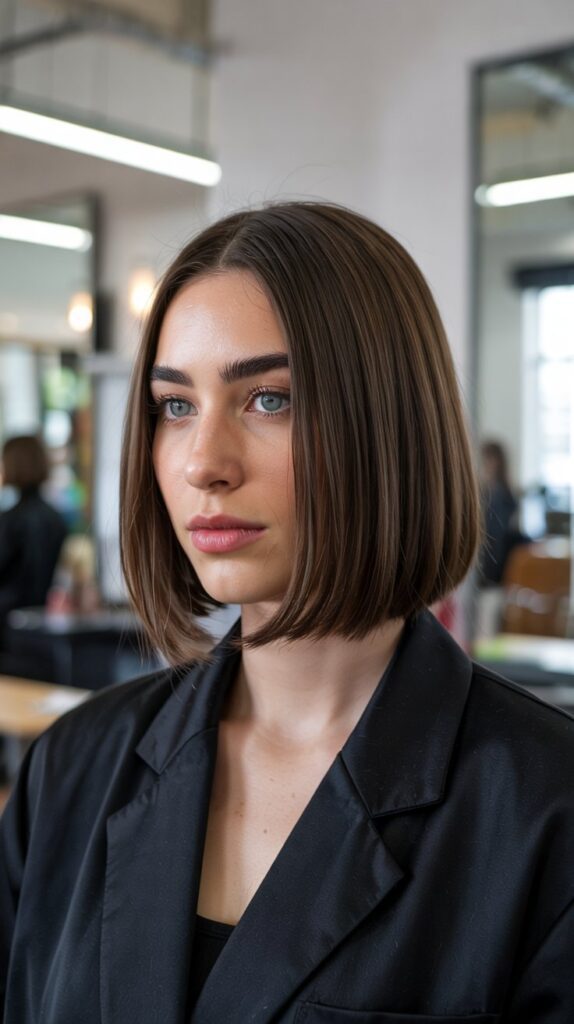
The blunt bob is a timeless haircut that creates the perfect illusion of thickness by keeping all your hair at one uniform length.
This cut eliminates the see-through ends that often plague thin hair, giving you a fuller, more solid appearance that exudes confidence and polish.
- The blunt cut line creates a visual weight at the bottom, making hair appear denser and more substantial than it actually is.
- By removing tapered ends, this style eliminates the wispy, thin look that can make fine hair seem sparse.
- The bob typically falls between chin and shoulder length, which is the ideal range for thin hair to maintain body without weighing down.
- Styling with a round brush and blow dryer can add extra lift at the roots, enhancing the fullness factor.
- This cut works particularly well for straight or slightly wavy hair textures that can hold the sharp, clean line.
- Adding a center or deep side part can create additional volume at the crown area.
- The maintenance is relatively low, requiring trims every 6-8 weeks to maintain the crisp, blunt edge.
2. Layered Pixie Cut

A layered pixie cut is one of the most liberating and volume-enhancing options for thin hair, removing weight and creating natural lift throughout the crown and top sections.
This short, textured style uses strategic layering to build height and dimension that longer hair simply cannot achieve.
- Short hair naturally has more body because there’s less weight pulling it down from the roots.
- Layers throughout the pixie create separation and texture, preventing hair from lying flat against the scalp.
- The crown area can be cut slightly longer to add height and create a flattering silhouette.
- Texturizing techniques like point cutting add movement and prevent the hair from looking too uniform or flat.
- This cut requires minimal styling—often just some texturizing paste or mousse worked through damp hair.
- The pixie grows out gracefully and can be styled differently as it lengthens, making it versatile.
- Regular trims every 4-6 weeks are necessary to maintain the shape and volume-boosting layers.
3. Long Layers with Face-Framing

Long layers with face-framing pieces offer the best of both worlds—maintaining length while strategically removing weight to create movement and volume throughout.
This approach uses graduated layers that start around the face and blend seamlessly into the length, adding dimension without sacrificing your hair’s overall appearance of fullness.
- Face-framing layers draw attention to your features while creating the illusion of fuller, more voluminous hair.
- The layers should start no shorter than cheekbone length to avoid creating a thin, stringy look around the face.
- Keeping the bulk of the length intact maintains the appearance of thickness at the ends.
- Internal layers remove weight from the interior of the hair without affecting the perimeter, creating natural movement.
- This technique works beautifully with both straight and wavy hair textures.
- Styling with a large-barrel curling iron or hot rollers amplifies the volume created by the layers.
- The graduated layers blend so seamlessly that the haircut grows out beautifully, extending time between salon visits.
4. Textured Lob (Long Bob)
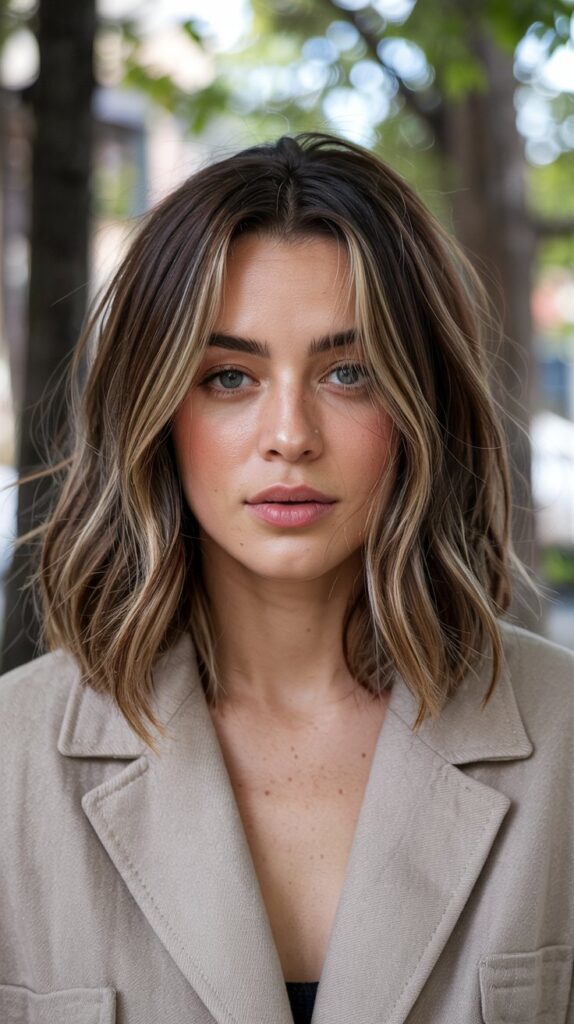
The textured lob combines the structure of a bob with the versatility of longer hair, incorporating subtle layers and texture to create a modern, voluminous look.
This shoulder-grazing cut is specifically designed to add body and movement to thin hair while remaining easy to style and maintain.
- The lob length hits at the collarbone or just above the shoulders, an optimal length for creating volume without excessive weight.
- Texturizing techniques throughout the cut create separation and prevent hair from clumping together and looking thin.
- Unlike a blunt lob, the textured version incorporates subtle layering that adds dimension and movement.
- This cut can be styled straight for a sleek look or with waves for added fullness and texture.
- The slightly longer length provides versatility for different styling options, including updos and half-up styles.
- Face-framing pieces can be incorporated to customize the cut for different face shapes.
- Maintenance is manageable with trims every 8-10 weeks to maintain the shape and remove any thinning ends.
5. Shaggy Layers
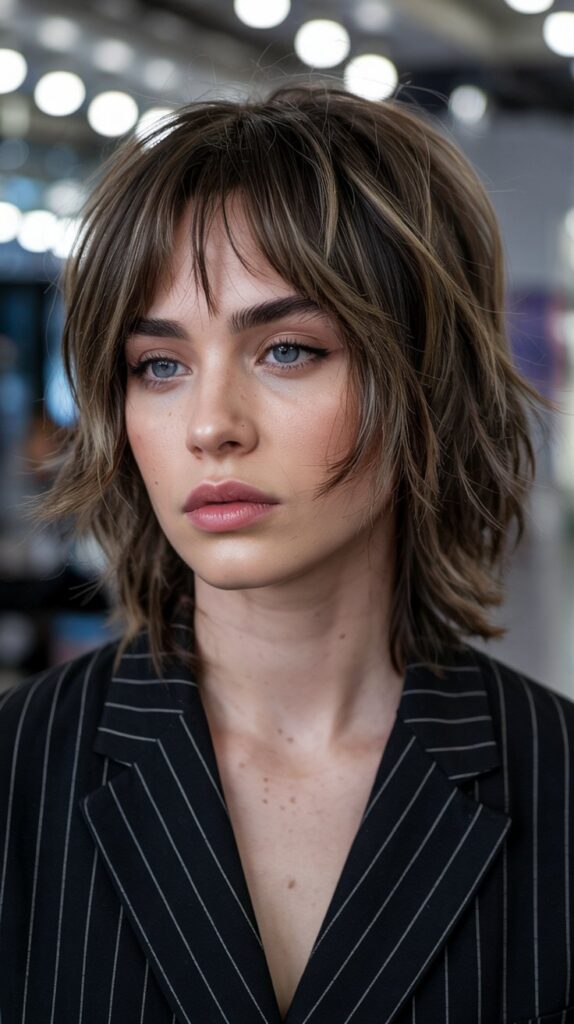
The shag haircut has made a major comeback and is particularly flattering for thin hair, using choppy, disconnected layers throughout to create maximum volume and texture.
This deliberately messy, rock-and-roll inspired cut removes weight strategically while creating the appearance of fuller, more abundant hair.
- The shag incorporates layers of varying lengths, creating dimension and preventing hair from lying flat.
- Choppy cutting techniques add texture and separation, making each strand more visible and creating fullness.
- This cut typically includes bangs or face-framing layers that add to the overall voluminous effect.
- The deliberately undone nature of the shag means it looks great with minimal styling effort.
- Different variations exist, from subtle modern shags to more dramatic 70s-inspired versions.
- This cut works across different lengths, from short to long, making it highly adaptable.
- The shag is ideal for those who want a low-maintenance, high-impact style that embraces natural texture.
6. Asymmetrical Bob
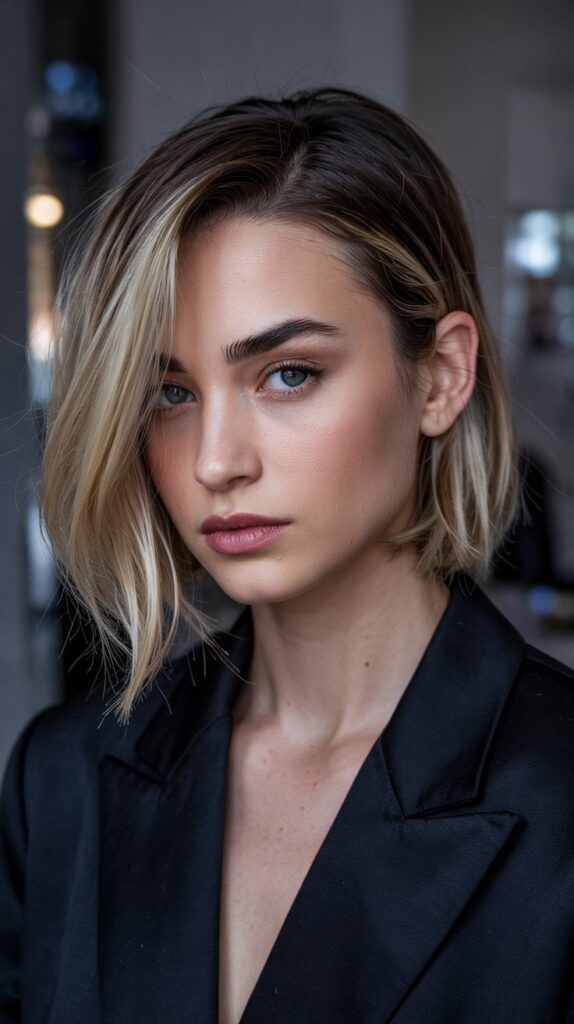
An asymmetrical bob features one side cut shorter than the other, creating visual interest and the illusion of more volume through its angular, modern shape. This bold cut draws the eye and creates dimension that makes thin hair appear fuller and more substantial.
- The dramatic angle and uneven lengths create visual volume and interest that distracts from thin hair’s lack of density.
- The shorter side can be tucked behind the ear to showcase the longer side, creating an asymmetrical silhouette.
- This cut typically features a blunt edge on the longer side, which adds to the fullness illusion.
- The asymmetry creates natural movement as the hair falls forward, adding body and dimension.
- This style makes a bold statement and works particularly well for those with oval or heart-shaped faces.
- Styling is straightforward—usually just blow-drying smooth with a paddle brush or adding slight waves.
- Regular maintenance every 6-8 weeks is essential to preserve the dramatic angle and shape.
7. Micro Fringe with Layers
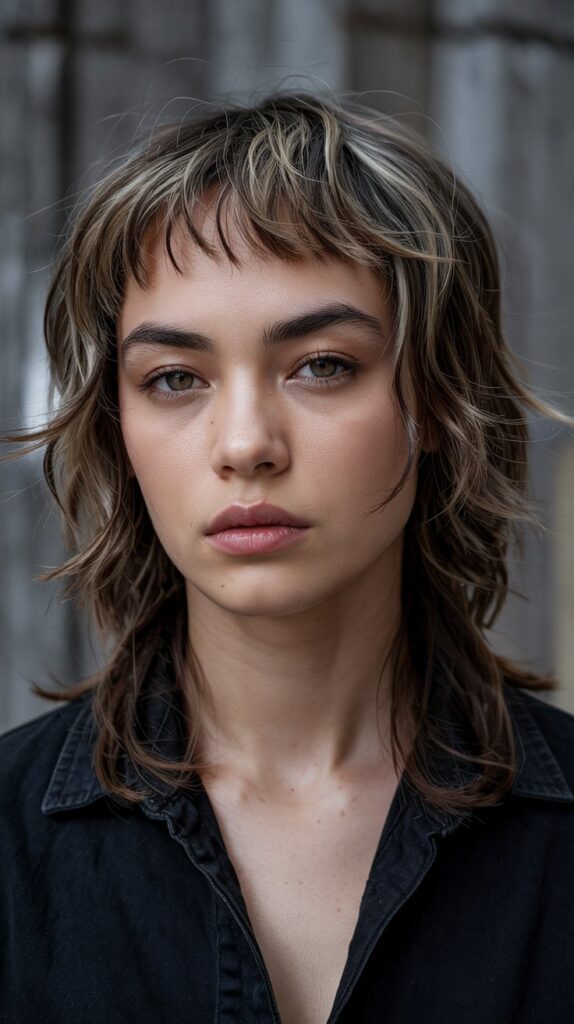
A micro fringe (also called baby bangs) combined with layers creates a youthful, edgy look while strategically adding volume and frame to thin hair. This bold style choice draws attention upward and creates the appearance of more hair through the contrast of the short fringe against longer layers.
- The micro fringe sits high on the forehead, creating a focal point that draws attention away from thin hair’s lack of density.
- Layers behind the fringe add movement and volume, preventing hair from lying flat against the head.
- This combination works especially well with medium to long hair, creating contrast and dimension.
- The short bangs require minimal styling—usually just a quick blow-dry or straightening.
- This bold look suits those with strong style preferences and confidence to carry an unconventional cut.
- The fringe creates the illusion of more hair by adding another distinct section to your overall style.
- Maintenance includes frequent bang trims every 2-3 weeks to keep the micro fringe at the proper length.
8. Feathered Layers
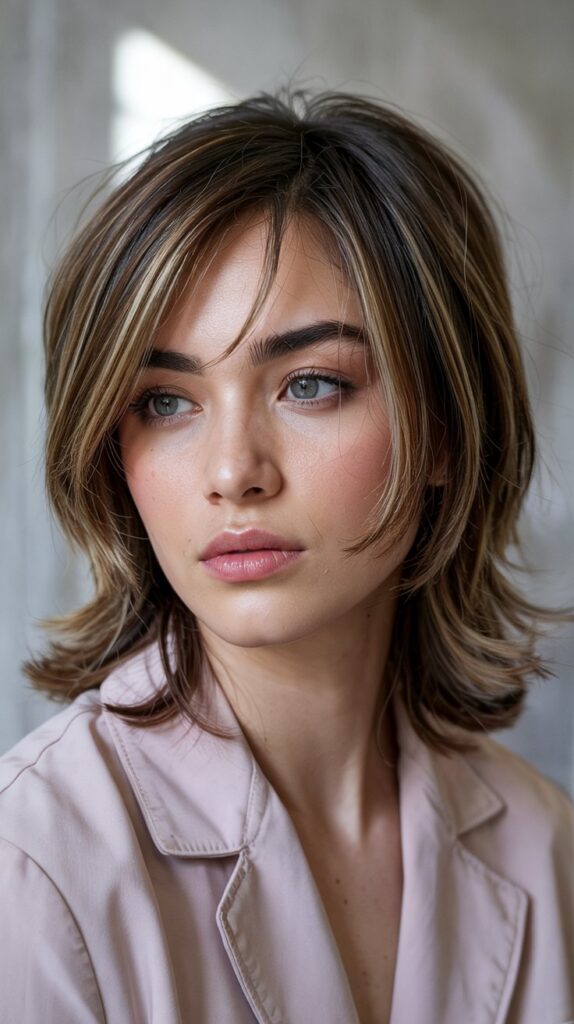
Feathered layers create soft, flowing movement through strategically placed cuts that taper and blend seamlessly into each other, adding dimension and the appearance of volume to thin hair.
This technique, popularized in the 1970s and modernized for today, uses razoring or point-cutting to create wispy, voluminous layers.
- Feathering creates soft, tapered ends that blend together, adding texture without creating harsh lines.
- This technique removes bulk from thick sections while creating the illusion of more hair for thin strands.
- The layers are typically concentrated around the crown and mid-lengths for maximum volume impact.
- Feathered cuts work beautifully with blow-drying and round brushing to enhance the lifted, voluminous effect.
- This style is particularly flattering for those who want soft, feminine movement rather than edgy texture.
- The feathering technique can be applied to various lengths, from short to long.
- Regular trims every 8-10 weeks maintain the soft, blended appearance of the feathered layers.
9. Angled Bob with Stacked Back
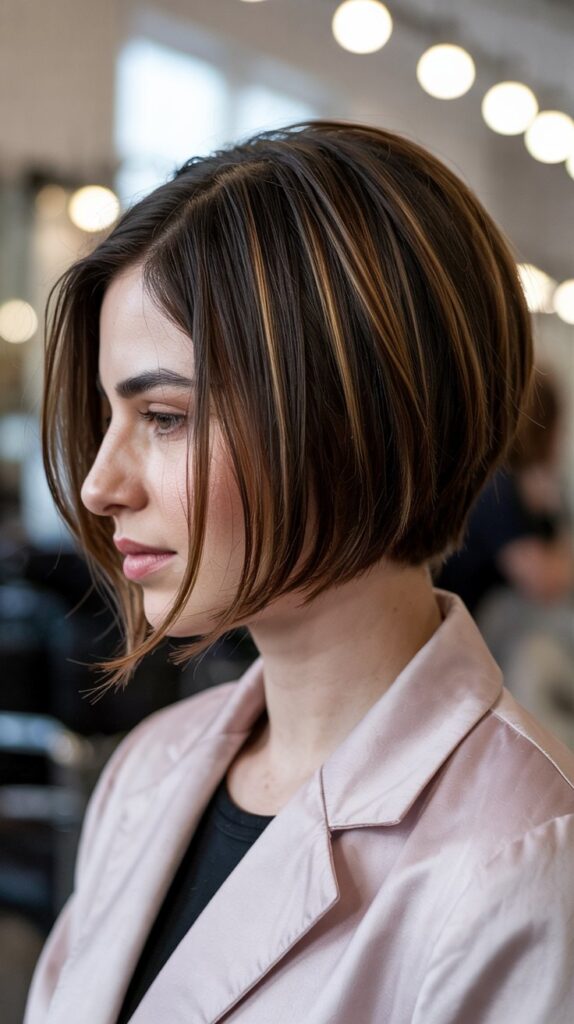
An angled bob with a stacked back combines length in front with graduated, layered volume in the back, creating a style that’s both modern and incredibly volumizing for thin hair.
The stacked back builds height and fullness while the longer front pieces maintain a feminine, face-framing appearance.
- The stacked back uses graduated layers that create natural lift and volume at the crown and nape area.
- Short layers in the back remove weight, allowing hair to lift away from the scalp naturally.
- The angle from back to front creates visual interest and the illusion of more abundant hair.
- This cut provides fullness where thin hair typically falls flattest—at the back of the head.
- The longer front pieces frame the face and provide versatility in styling.
- Stacked bobs require regular maintenance every 5-7 weeks to preserve the graduated layers and shape.
- Styling typically involves blow-drying with a round brush to enhance the lift in the stacked sections.
10. Curtain Bangs with Soft Layers
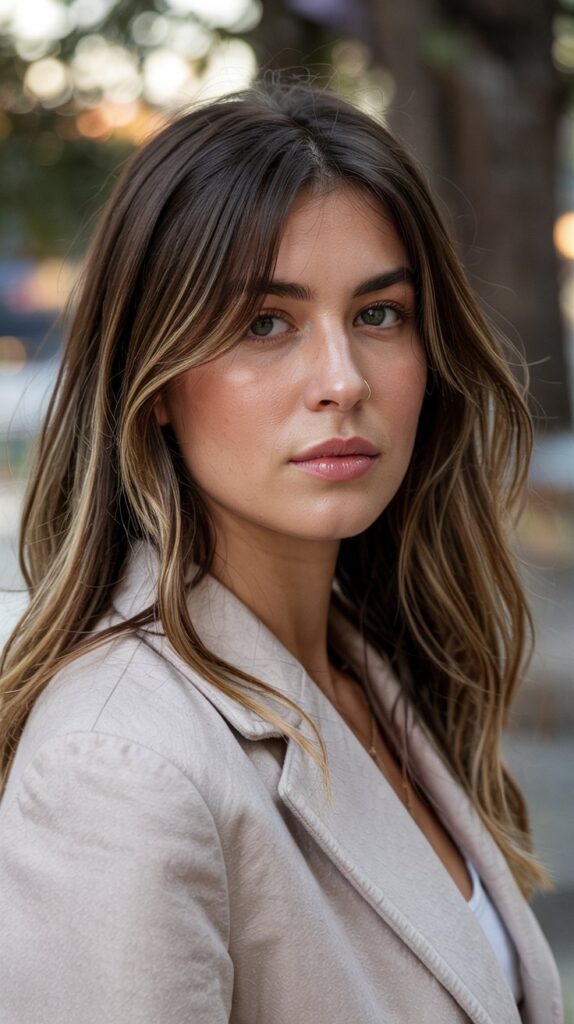
Curtain bangs frame the face beautifully while soft layers throughout add dimension and volume to thin hair, creating a romantic, effortless look.
This combination has become incredibly popular because it flatters virtually every face shape while making thin hair appear fuller and more styled.
- Curtain bangs part down the middle and sweep to either side, creating width and framing the face attractively.
- The bangs add a focal point and create the illusion of more hair by adding another dimension to your style.
- Soft layers throughout the length prevent hair from looking flat or stringy while maintaining overall fullness.
- This style works with various hair lengths, from lob-length to long hair.
- Curtain bangs grow out gracefully and can be easily incorporated into the rest of your hair as they lengthen.
- Styling is minimal—usually just blow-drying the bangs away from the face with a round brush.
- This cut is highly versatile and can be worn straight, wavy, or curled depending on your preference.
11. Choppy Bob

A choppy bob uses intentionally uneven, textured cutting techniques to create a piece-y, voluminous look that’s perfect for thin hair.
This modern take on the classic bob adds edge and dimension through deliberate irregularity in the cut.
- Choppy cutting techniques create separation between sections, making thin hair appear fuller and more textured.
- The irregular ends prevent hair from clumping together and looking sparse or thin.
- This cut typically incorporates both blunt and textured sections for maximum visual interest.
- Point-cutting and razoring techniques create the choppy effect while removing weight.
- The style looks effortlessly cool with minimal styling—often just air-drying with texturizing product.
- Choppy bobs work well for straight to slightly wavy hair textures.
- This cut requires maintenance every 6-8 weeks to maintain the textured, choppy appearance.
12. Graduated Bob
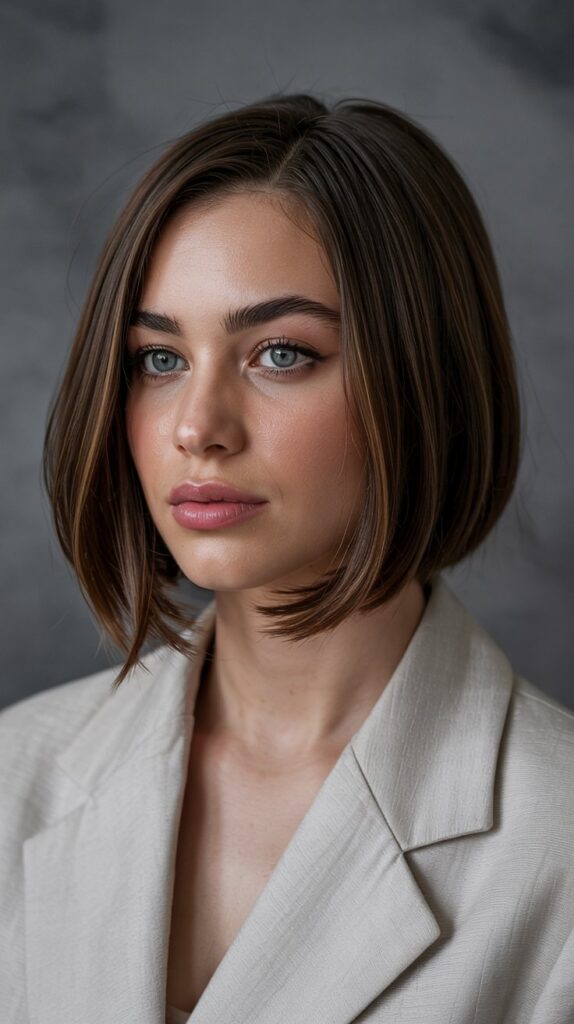
A graduated bob features shorter layers in the back that gradually become longer toward the front, creating a stacked, voluminous silhouette that’s ideal for thin hair.
This precision cut builds height and fullness while maintaining a polished, sophisticated appearance.
- The graduation creates natural lift and volume, especially in the back and crown areas where thin hair often falls flat.
- Shorter back layers stack upon each other, building height and fullness.
- The length gradually increases toward the face, creating an elegant, elongating effect.
- This structured cut provides shape even without extensive styling, making it ideal for busy lifestyles.
- The precision of the cut means it maintains its shape well as it grows.
- Graduated bobs work beautifully for straight hair and can add structure to slightly wavy textures.
- Regular trims every 6-8 weeks are necessary to maintain the graduation and volume.
13. Razored Pixie

A razored pixie uses razor-cutting techniques to create ultra-textured, piece-y layers that maximize volume and movement in thin hair.
This edgy, modern cut removes weight while creating separation and dimension that makes fine hair appear fuller and more dynamic.
- Razor cutting creates softer, more textured ends compared to scissor cutting, adding movement and dimension.
- The technique removes bulk while creating feathery, separated pieces that enhance volume.
- This cut works exceptionally well for very fine, thin hair that needs maximum lift and body.
- The textured nature means it looks great with minimal styling—often just product and finger-styling.
- Razored pixies can be customized with longer tops, side-swept sections, or asymmetrical elements.
- This cut requires frequent maintenance every 4-5 weeks to keep the texture and shape fresh.
- The edgy, textured look is perfect for those who want a bold, fashion-forward style.
14. Butterfly Layers

Butterfly layers create a beautiful cascading effect with shorter layers around the crown that gradually lengthen, resembling butterfly wings and adding incredible volume to thin hair.
This trendy cut creates dimension and movement while maintaining length throughout the perimeter.
- The shorter crown layers create instant lift and volume at the top of the head where it’s most needed.
- Layers gradually lengthen as they move down, creating a beautiful flowing effect.
- This technique maintains length at the perimeter while removing weight from the interior.
- The layering creates natural movement and prevents hair from lying flat against the head.
- Butterfly layers work well with both straight and wavy hair textures.
- Styling with a blow dryer and round brush enhances the voluminous effect of the layers.
- This cut requires trims every 8-10 weeks to maintain the distinct layering pattern.
15. Blunt Lob with Subtle Internal Layers
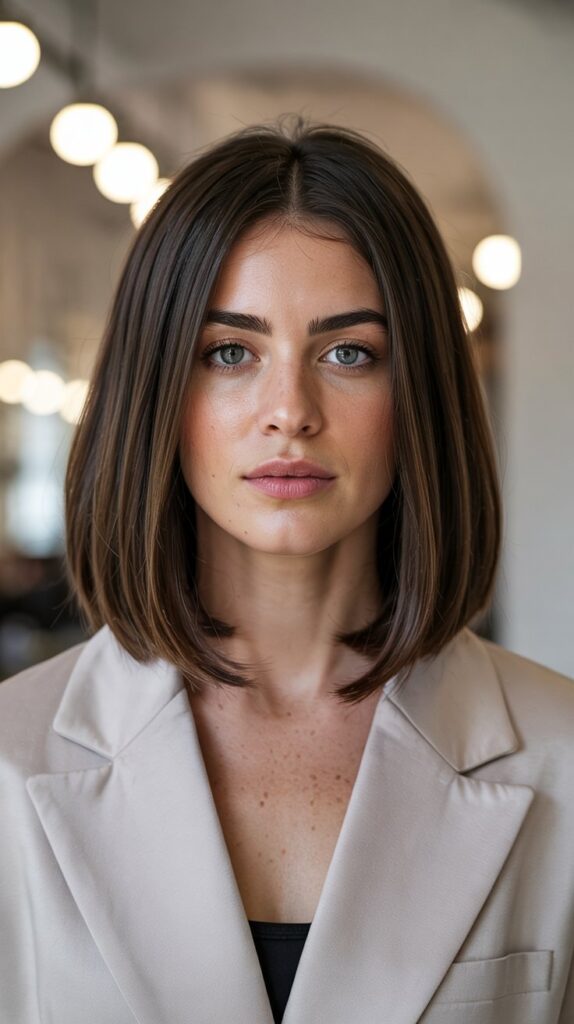
A blunt lob with subtle internal layers maintains a full, solid perimeter while strategically removing weight from the inside, creating natural movement and volume without sacrificing the appearance of thickness.
This sophisticated cut offers the best of both worlds for thin hair.
- The blunt perimeter creates the illusion of density and fullness at the ends.
- Internal layers remove weight from the interior without affecting the outside appearance.
- This technique allows for natural movement and body while maintaining a thick-looking silhouette.
- The cut works beautifully for those who want length and fullness without visible layering.
- Styling is versatile—looks great straight, wavy, or with subtle bends.
- The solid perimeter makes hair appear healthier and fuller than layered ends would.
- Maintenance requires trims every 8-10 weeks to keep the blunt edge crisp and remove any splitting.
16. Wispy Bangs with Layered Cut
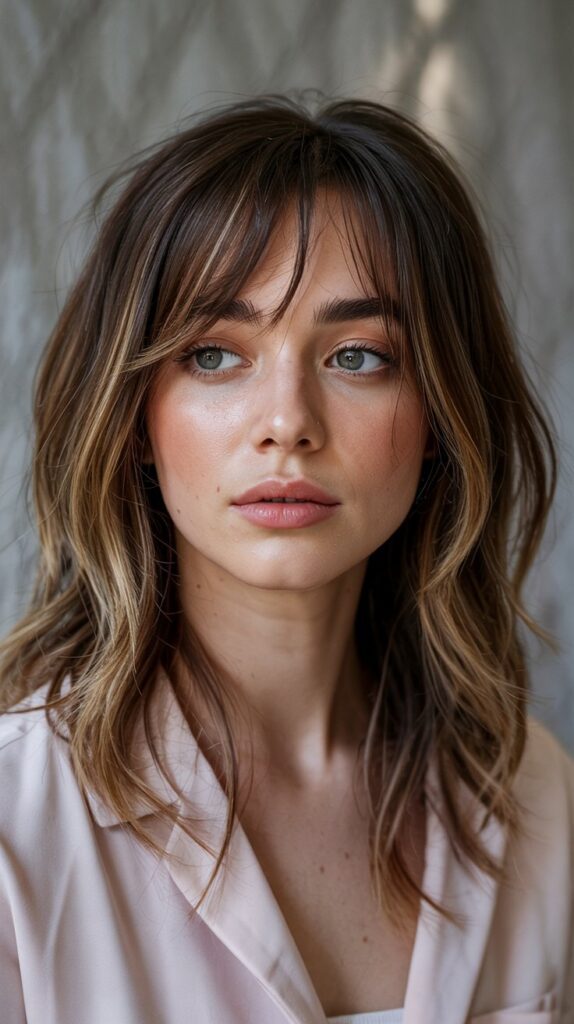
Wispy bangs combined with layered hair throughout create a soft, romantic look that adds dimension and the appearance of more hair.
The delicate, see-through nature of wispy bangs contrasts beautifully with fuller layers behind, creating visual interest and volume.
- Wispy bangs are intentionally thin and textured, creating a soft, face-framing effect without weighing down the forehead.
- The see-through quality of the bangs adds softness while the layers behind provide volume and movement.
- This combination is less commitment than full, heavy bangs while still providing the framing effect.
- The layers throughout add body and dimension, preventing hair from appearing flat or one-dimensional.
- Wispy bangs are low-maintenance and grow out gracefully, blending easily into the rest of the hair.
- This style works for various hair lengths from shoulder-length to long hair.
- Minimal styling is required—usually just blow-drying the bangs to the side and adding texture to the layers.
17. Inverted Bob

An inverted bob features stacked layers in the back with longer front pieces, creating dramatic volume and a modern silhouette that’s particularly flattering for thin hair.
The inverted angle draws the eye and creates the illusion of fuller, more abundant hair.
- The stacked back creates significant height and volume at the crown and nape area.
- Longer front pieces provide face-framing and elongation while the back provides drama and lift.
- The inverted angle is more dramatic than a standard angled bob, creating maximum visual impact.
- This cut naturally lifts away from the scalp, solving the common problem of thin hair lying flat.
- The precision cut maintains its shape well and looks polished with minimal effort.
- Inverted bobs work best for straight to slightly wavy hair that can hold the structured shape.
- Regular maintenance every 5-7 weeks is essential to preserve the stacked layers and dramatic angle.
18. Textured Crop
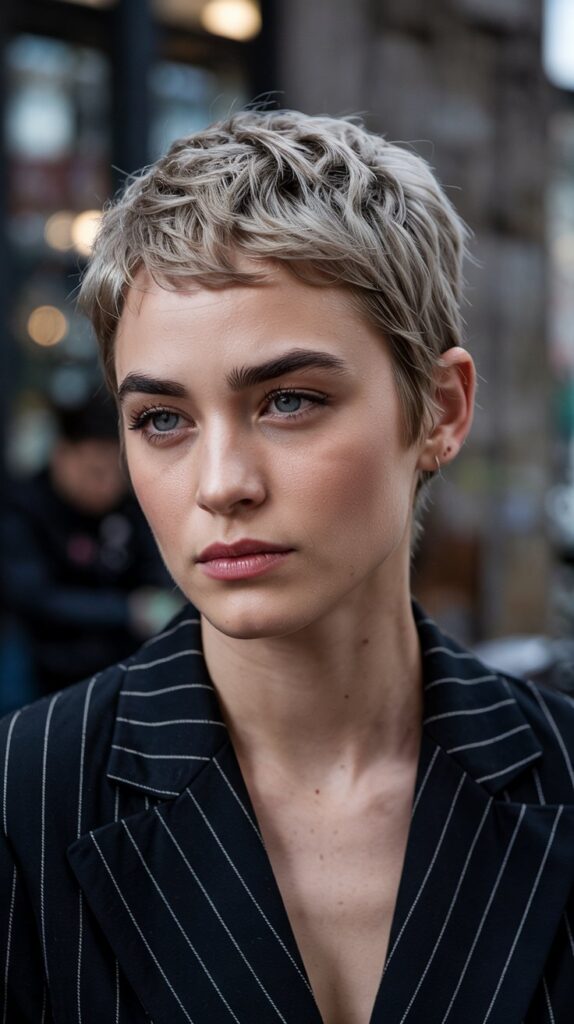
A textured crop is an ultra-short, piece-y cut that maximizes volume through strategic layering and texturizing, perfect for those ready to embrace minimal length for maximum fullness.
This confident, fashion-forward cut removes all weight, allowing thin hair to achieve its fullest potential.
- The very short length means there’s virtually no weight pulling hair down, creating natural lift and volume.
- Texturizing techniques throughout create separation and dimension, preventing flatness.
- This cut is incredibly low-maintenance, often requiring only product and finger-styling.
- The crop can be customized with longer sections on top, side-swept elements, or varying lengths.
- This style is ideal for those with very fine, thin hair who struggle with volume at longer lengths.
- The bold, minimal length makes a strong style statement and frames facial features beautifully.
- Maintenance every 4-5 weeks keeps the crop looking fresh and maintains the textured, piece-y appearance.
19. Side-Swept Undercut Pixie
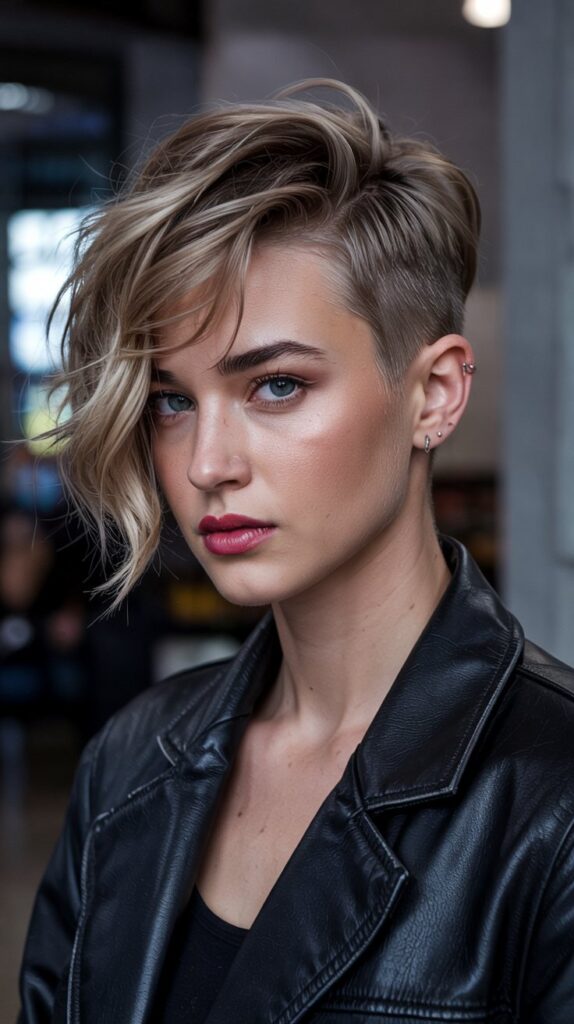
A side-swept undercut pixie combines volume on top with trimmed or shaved sides, creating dramatic contrast and the illusion of incredibly thick hair on top.
This edgy style concentrates fullness where it’s most visible while removing bulk from the sides.
- The undercut removes hair from the sides and back, concentrating all volume and attention on the top section.
- Side-swept styling creates height and drama, making the remaining hair appear fuller and more substantial.
- This cut creates strong visual interest through the contrast between shaved and longer sections.
- The style is surprisingly versatile and can be worn sleek or textured depending on preference.
- The undercut reduces overall hair volume, making the remaining hair easier to style with more apparent fullness.
- This bold look suits those comfortable with regular maintenance and an edgy aesthetic.
- The undercut requires touch-ups every 3-4 weeks while the top section needs trimming every 6-8 weeks.
20. Layered Shag with Bangs

A layered shag with bangs combines the volume-boosting power of shag layers with face-framing bangs, creating a bohemian, rock-and-roll inspired look that makes thin hair appear full and textured.
This comprehensive approach to layering ensures movement and dimension throughout.
- The combination of shag layers and bangs creates multiple levels of dimension and visual interest.
- Choppy, disconnected layers throughout prevent hair from clumping and appearing thin.
- Bangs add another element that increases the overall appearance of hair abundance.
- This style works across various lengths, from medium to long hair.
- The intentionally messy, undone nature means it looks great with minimal styling effort.
- Texture and movement are built into the cut, so natural air-drying often produces beautiful results.
- Regular trims every 8-10 weeks maintain the shaggy layers and keep bangs at the proper length.
21. A-Line Bob
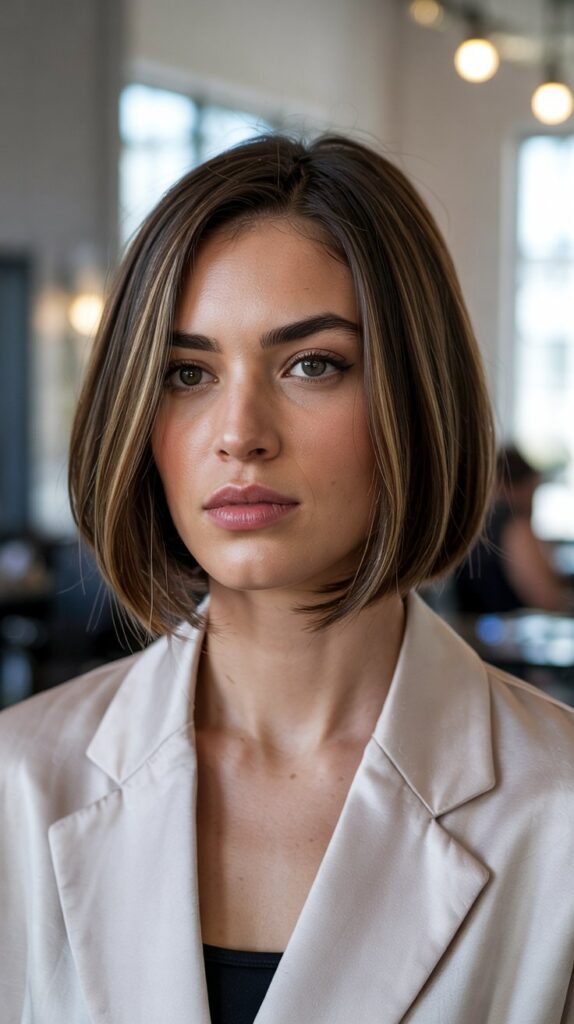
An A-line bob features hair that’s shorter in the back and gradually becomes longer toward the front, creating a flattering angle that adds visual volume and frames the face beautifully.
This classic cut is particularly effective for thin hair because the angle creates the illusion of fullness and movement.
- The A-line angle creates visual interest and the perception of more hair through its geometric shape.
- Shorter back sections naturally lift away from the scalp, creating volume where thin hair typically falls flat.
- The longer front pieces frame the face and provide versatility in styling.
- This cut maintains a relatively blunt perimeter, which contributes to the appearance of thickness.
- A-line bobs work beautifully for straight hair and can add structure to wavy textures.
- The clean, precise cut looks polished with minimal styling, making it ideal for professional settings.
- Regular trims every 6-8 weeks maintain the angle and keep the cut looking fresh and intentional.
22. Tousled Layers
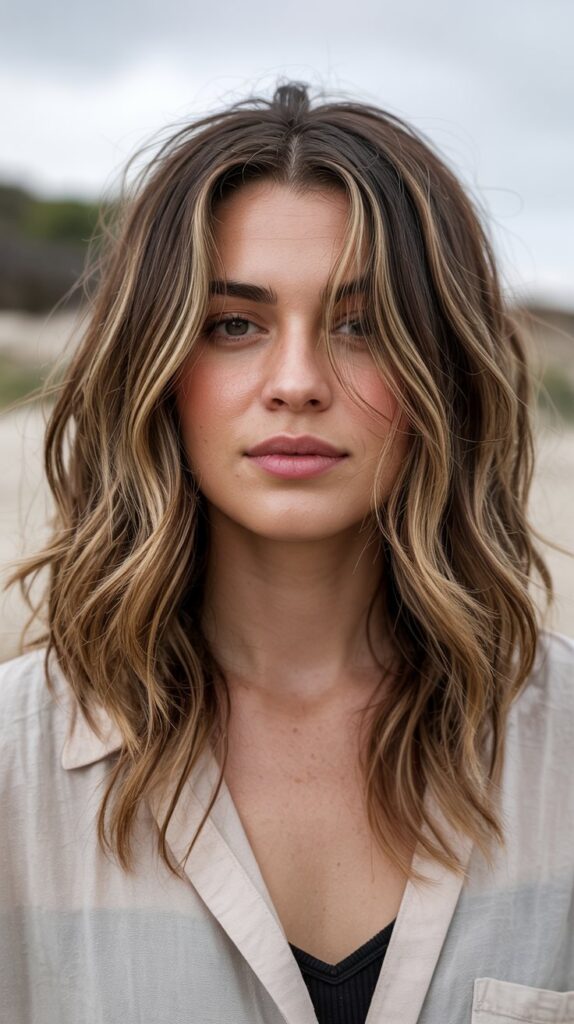
Tousled layers create an effortlessly undone look through strategically placed layers that add movement, texture, and volume to thin hair. This relaxed, beachy style embraces natural texture while strategically building fullness throughout.
- Layers are cut to create natural movement and prevent hair from lying flat or appearing one-dimensional.
- The tousled styling enhances the volume created by the layers, making hair appear fuller and more abundant.
- This low-maintenance style works with natural texture rather than fighting against it.
- Varying layer lengths create dimension and visual interest throughout the hair.
- The style can be achieved with minimal heat styling—often just texturizing spray and air-drying or gentle scrunching.
- Tousled layers work across different lengths, from lobs to long hair.
- This forgiving cut grows out gracefully and requires trims only every 10-12 weeks.
23. Pixie with Longer Top
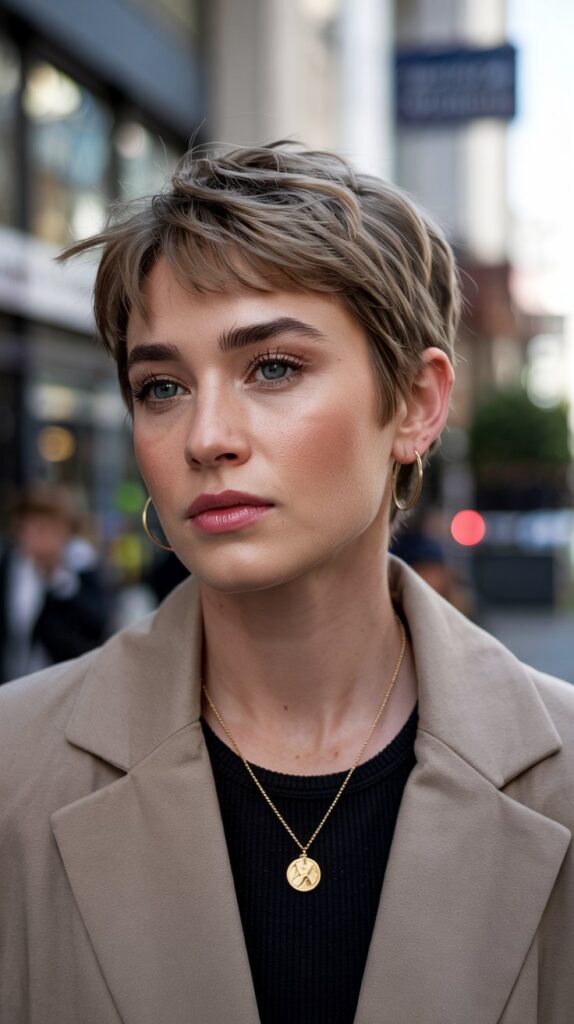
A pixie with a longer top section creates maximum volume and versatility while keeping sides and back short for contrast and easy maintenance. This modern pixie variation allows for styling options while maintaining the volume-boosting benefits of short hair.
- The longer top section can be styled up, forward, or to the side, creating height and drama.
- Keeping sides and back short removes bulk and draws all attention to the voluminous top.
- This cut provides versatility—the top can be styled sleek, textured, or even tucked behind ears for different looks.
- The length contrast creates the illusion of abundant hair in the most visible area.
- This style works particularly well for those with oval or heart-shaped faces.
- The longer top can be styled with pomade, wax, or mousse to create various looks from polished to edgy.
- Maintenance includes trimming sides and back every 3-4 weeks and the top every 6-8 weeks.
24. Collarbone Cut with Flipped Ends
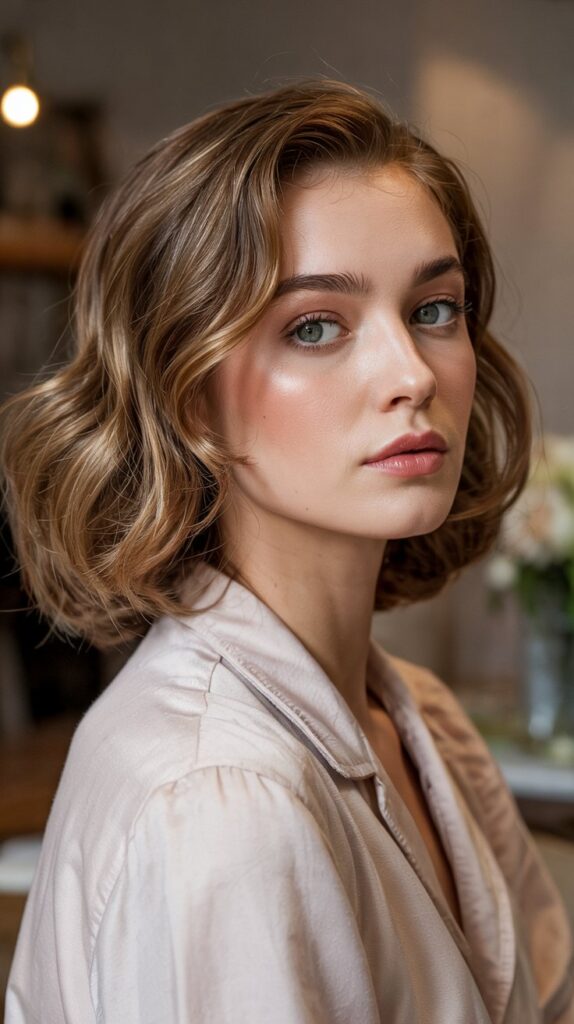
A collarbone-length cut with flipped ends creates a retro-inspired, voluminous look that makes thin hair appear fuller and more bouncy.
The outward flip at the ends adds width and visual volume, creating a flattering, feminine silhouette.
- Flipping the ends outward creates width and the illusion of more hair at the perimeter.
- The collarbone length is ideal for thin hair—long enough for styling versatility but short enough to maintain body.
- This style can be achieved with a round brush while blow-drying or with hot rollers for longer-lasting results.
- The flipped ends create a polished, finished look that appears intentional and styled.
- This cut works beautifully for those who enjoy more classic, feminine styling.
- Adding face-framing layers enhances the overall volume and movement of the style.
- Regular trims every 8-10 weeks keep the ends healthy and maintain the cut’s ability to hold the flip.
25. Disconnected Layers
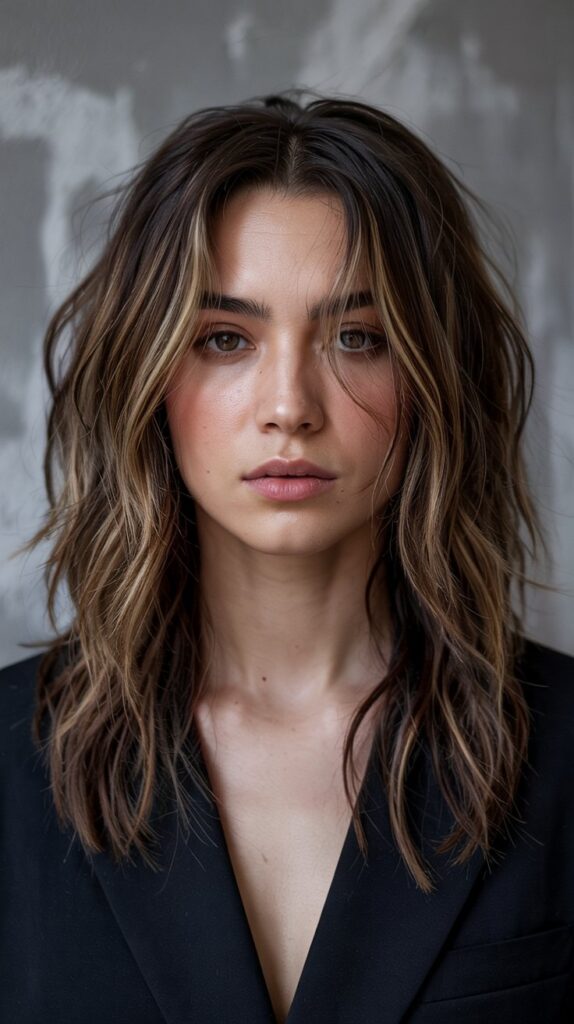
Disconnected layers feature distinct sections of different lengths rather than seamlessly blended layers, creating dramatic texture and volume that’s perfect for thin hair.
This modern cutting technique adds visual interest and the illusion of fuller hair through intentional irregularity.
- Disconnected sections create gaps and separation, preventing thin hair from appearing flat or stringy.
- The varying lengths add dimension and make it impossible for hair to lie uniformly flat.
- This edgy technique creates a modern, fashion-forward look that’s gained popularity in recent years.
- The disconnection adds movement and allows different sections to move independently, creating natural volume.
- This cut works well for those who want maximum texture and a bold, unconventional style.
- Styling can be minimal—often just texturizing product worked through the layers.
- Regular trims every 8-10 weeks maintain the distinct disconnected sections and overall shape.
26. Crown Layers with Blunt Ends
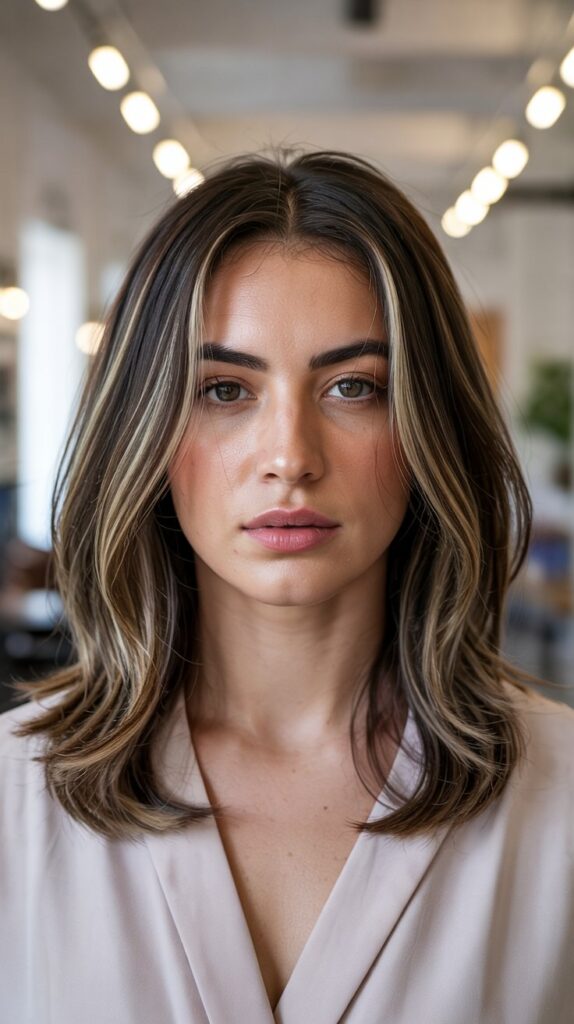
Crown layers with blunt ends combine strategic layering at the top for volume with a solid perimeter for the appearance of thickness—the perfect combination for thin hair.
This hybrid approach targets the areas that need lift while maintaining fullness where it’s most visible.
- Layers concentrated at the crown create lift and volume in the area where thin hair typically falls flattest.
- The blunt perimeter maintains the appearance of thick, healthy ends without thinning or wisps.
- This technique provides the benefits of layers without sacrificing the visual density that solid ends create.
- The crown volume balances proportions and creates a flattering silhouette.
- This cut works across various lengths from shoulder-length to long hair.
- Styling the crown layers with a round brush while blow-drying maximizes the volumizing effect.
- Regular trims every 8-10 weeks maintain both the crown layers and the blunt perimeter.
27. Soft Undercut Bob
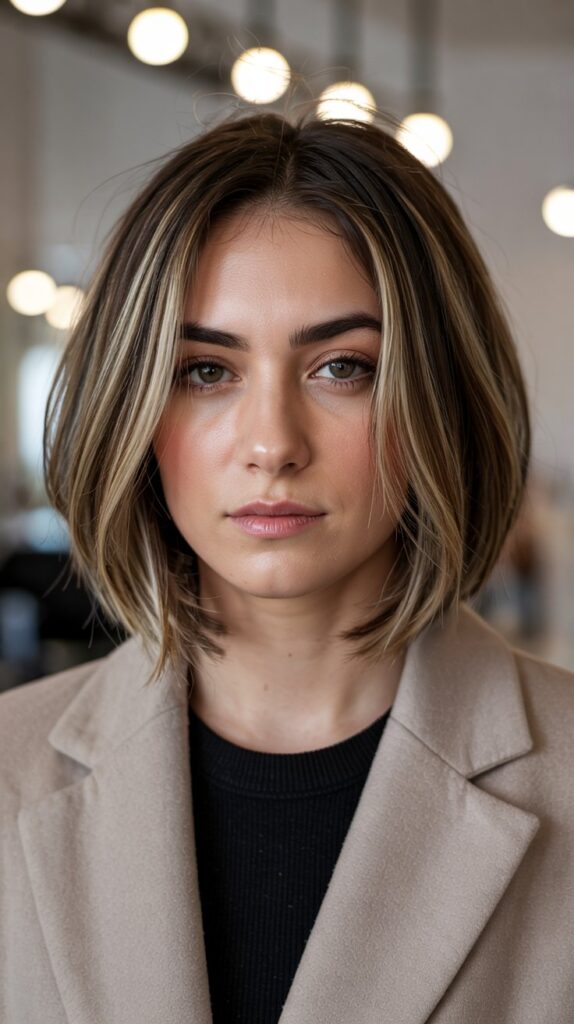
A soft undercut bob features subtle undercutting in the nape area hidden beneath the top layers, removing bulk and allowing the visible hair to appear fuller and more voluminous.
This modern technique provides volume benefits without the dramatic visibility of traditional undercuts.
- The hidden undercut removes weight from underneath, allowing top layers to lift and move more freely.
- Unlike visible undercuts, this technique is concealed when hair is worn down, maintaining a classic appearance.
- The reduced bulk in the nape area prevents hair from getting weighed down and falling flat.
- This approach is perfect for those who want the benefits of an undercut without the bold aesthetic.
- The soft undercut can be customized in terms of how high it extends and how much hair is removed.
- When hair is worn in updos or ponytails, the undercut adds an element of surprise and edge.
- Maintenance requires touch-ups to the undercut section every 6-8 weeks and regular trims to the visible layers.
Expert Tips for Maintaining Volume in Thin Hair
Beyond choosing the right haircut, maintaining volume in thin hair requires proper care, styling techniques, and product selection. These expert strategies will help you maximize the fullness potential of your new cut.
- Use volumizing shampoos and conditioners specifically formulated for fine hair to avoid weighing down strands.
- Apply conditioner only to the mid-lengths and ends, never to the roots, to prevent flatness at the scalp.
- Blow-dry hair upside down or lift sections away from the scalp while drying to create maximum root volume.
- Incorporate dry shampoo or texturizing spray at the roots between washes to maintain lift and body.
- Avoid heavy oils, serums, and styling products that can weigh down thin hair and make it appear even thinner.
- Consider using velcro rollers or hot rollers to create lasting volume without the damage of excessive heat styling.
- Sleep with hair in a loose, high ponytail or bun to preserve volume and prevent flattening overnight.
- Get regular trims every 6-10 weeks depending on your cut to maintain the shape and remove thin, damaged ends.
- Use a lightweight mousse or root-lifting spray on damp hair before styling for all-day volume.
- Avoid over-washing hair.
- Avoid over-washing hair, as daily shampooing can strip natural oils that provide texture and body; aim for every 2-3 days instead.
- Invest in a quality round brush with mixed bristles for blow-drying, as it creates more lift than paddle brushes.
- Consider changing your part periodically, as hair tends to fall flat when always parted in the same place.
- Use cool air to finish blow-drying, as it helps set the style and maintain volume throughout the day.
- Apply volumizing products to damp hair rather than dry hair for better distribution and absorption.
- Backcomb or tease the crown area gently for special occasions, using a fine-tooth comb and hairspray for hold.
- Choose hair accessories like clips and headbands strategically to add height and prevent flatness.
- Consult with your stylist about whether highlights or balayage might create the illusion of dimension and fullness.
- Avoid tight hairstyles like slicked-back ponytails that emphasize thinness and create scalp tension.
- Consider professional volumizing treatments or keratin smoothing that adds body without weight.
Styling Products That Enhance Volume
Selecting the right products is crucial for maintaining the volume your haircut creates. These product categories and application techniques will help you achieve maximum fullness with thin hair.
- Volumizing mousses provide lift and hold when applied to damp hair before blow-drying without heaviness.
- Root-lifting sprays target the scalp area specifically, creating lift where thin hair most needs it.
- Texturizing sprays add grit and separation to finished styles, making hair appear fuller and more piece-y.
- Dry shampoos absorb oil while adding texture and body, extending time between washes and maintaining volume.
- Lightweight hairsprays hold volume without the stiffness or weight of traditional formulas that flatten thin hair.
- Sea salt sprays create beachy texture and grip, making hair appear thicker and more voluminous when air-dried.
- Volumizing powders can be sprinkled at the roots and massaged in for dramatic lift and fullness.
- Thickening creams coat individual strands to make them appear fuller without greasy residue.
- Apply products sparingly—thin hair requires less product than you might think to avoid weighing it down.
- Layer products strategically: mousse on damp hair, dry shampoo at roots after styling, and texturizing spray for finishing touches.
- Avoid silicone-heavy products that create temporary smoothness but ultimately flatten and weigh down thin hair.
- Test products on a small section first to ensure they don’t make your hair look greasy or limp.
Common Mistakes to Avoid with Thin Hair
Understanding what not to do is just as important as knowing the right techniques. Avoid these common pitfalls that make thin hair appear even thinner and less voluminous.
- Growing hair too long: Excessive length adds weight that pulls hair flat and makes thinness more apparent; stick to medium lengths for maximum volume.
- Skipping regular trims: Split ends and damaged tips make thin hair look wispy and unhealthy rather than full and vibrant.
- Over-layering: Too many layers can remove so much bulk that hair appears stringy rather than voluminous; strategic layering is key.
- Using heavy conditioners: Rich, moisturizing formulas designed for thick or curly hair will weigh down fine strands significantly.
- Center parts on very thin hair: They can emphasize sparse areas on the scalp; side parts or zigzag parts often create more volume.
- Excessive heat styling: Daily flat ironing or curling can damage thin hair, making it break and appear even thinner over time.
- Tight hairstyles: Pulling thin hair back tightly in ponytails or buns can cause breakage and emphasize how little hair there is.
- Wrong hair color: All-over single-process dark colors can make the scalp more visible, while well-placed highlights add dimension.
- Brushing too frequently: Over-brushing can break delicate thin hair; use a wide-tooth comb on wet hair and minimal brushing when dry.
- Ignoring scalp health: A healthy scalp grows healthier hair; neglecting scalp care can worsen thinning issues over time.
- Using products with sulfates: Harsh sulfates strip natural oils that give thin hair texture and body, leaving it limp and flat.
- Sleeping with wet hair: This causes breakage and flattening; either dry completely or use protective styling before bed.
Face Shape Considerations for Volume Haircuts
Choosing a volumizing haircut that flatters your face shape ensures your thin hair looks not only fuller but also balanced and proportionate. These guidelines help you select the most flattering cut from the options presented.
Oval Face Shapes:
- Nearly any of these cuts will work beautifully with oval faces, as this balanced shape is universally flattering.
- Experiment with bolder choices like asymmetrical bobs or micro fringes since proportions are naturally harmonious.
- Focus on choosing based on personal style preference rather than face shape limitations.
Round Face Shapes:
- Opt for cuts with height at the crown like pixies with longer tops or butterfly layers to elongate.
- Choose angled or A-line bobs that create vertical lines rather than width.
- Avoid blunt cuts at chin length that add width; go shorter or longer instead.
- Side-swept styles and asymmetrical cuts create diagonal lines that slim and lengthen.
Square Face Shapes:
- Soft, feathered layers and wispy bangs soften strong jawlines beautifully.
- Textured lobs and shaggy layers that fall below the jaw create flattering angles.
- Avoid blunt, chin-length cuts that emphasize the width of the jaw.
- Curtain bangs and face-framing layers draw attention to eyes rather than angular features.
Heart Face Shapes:
- Chin-length bobs and lobs add width at the narrow chin area, creating balance.
- Wispy or curtain bangs balance a wider forehead beautifully.
- Avoid excessive volume at the crown which emphasizes the top-heavy proportions.
- Cuts with movement at the jawline create the most flattering silhouette.
Long/Oblong Face Shapes:
- Blunt bobs and lobs at collarbone length add horizontal width that balances length.
- Bangs of any type shorten the appearance of a long face significantly.
- Avoid long, vertical styles without bangs that elongate further.
- Volume at the sides rather than excessive height at the crown creates better proportions.
Haircut Consultation Tips
Getting the best volumizing haircut for your thin hair starts with effective communication with your stylist. These consultation strategies ensure you leave the salon with exactly what you envisioned.
- Bring multiple reference photos showing the haircut from different angles—front, back, and sides provide complete context.
- Be honest about your styling routine and how much time you’re willing to spend on daily maintenance.
- Discuss your hair’s specific challenges: Does it fall flat quickly? Break easily? Refuse to hold curl?
- Ask your stylist to explain their cutting plan before they begin, ensuring you’re both aligned on the approach.
- Inquire about recommended styling products and techniques specifically for your new cut and hair type.
- Discuss your lifestyle—active routines might require different cuts than office-based schedules.
- Be realistic about the dramatic nature of change you’re comfortable with; some cuts represent major transformations.
- Ask about the grow-out process and how the cut will look at various stages between appointments.
- Request a brief styling tutorial before you leave the salon so you can recreate the look at home.
- Discuss color options that might enhance volume through dimension and depth without damaging thin hair.
- Trust your stylist’s expertise when they suggest modifications to your inspiration photos based on your hair type.
- Schedule your appointment when you have time afterward to practice styling before an important event.
Color Techniques That Enhance Volume Illusion
Strategic hair color can significantly enhance the appearance of volume in thin hair by creating dimension, depth, and the illusion of layers. These coloring techniques work synergistically with your volumizing haircut.
- Balayage highlighting creates natural-looking dimension that makes hair appear fuller and more multidimensional.
- Babylights are delicate, fine highlights that add subtle dimension without harsh contrast or obvious color lines.
- Lowlights add depth and shadow that create the illusion of layers and volume where none exists structurally.
- Root shadowing creates dimension at the scalp that makes hair appear denser and reduces visible scalp show-through.
- Glossing treatments add shine that reflects light, making thin hair appear healthier and more abundant.
- Avoid all-over solid dark colors, especially very dark shades, as they can make the scalp more visible through thin hair.
- Strategic placement of lighter pieces around the face draws attention and creates a framing effect that suggests fullness.
- Multi-tonal color prevents hair from looking flat and one-dimensional, adding visual interest and perceived texture.
- Ask for color that’s no more than 2-3 shades different from your natural color to maintain a natural appearance.
- Consider semi-permanent or demi-permanent color options that are less damaging to already-delicate thin hair.
- Maintain color health with purple or blue-toning shampoos that prevent brassiness and keep color vibrant.
- Schedule color appointments to coincide with cuts when possible to minimize salon visits and overall hair manipulation.
Professional Treatments for Volume Enhancement
Beyond haircuts and home care, professional salon treatments can significantly improve the appearance and manageability of thin hair. These treatments work in conjunction with your volumizing cut to maximize fullness.
- Keratin volumizing treatments differ from smoothing treatments by adding body and thickness to each strand rather than flattening.
- Olaplex or bond-building treatments strengthen thin hair from within, preventing breakage that makes hair appear even thinner.
- Scalp treatments improve follicle health and circulation, potentially improving hair growth and overall thickness over time.
- Professional volumizing treatments deposit proteins and polymers that temporarily plump each hair strand.
- Deep conditioning treatments specifically formulated for fine hair add moisture without weight or flatness.
- Brazilian blowouts for volume differ from traditional smoothing treatments and can actually enhance body and movement.
- Root perms create lasting lift at the crown area without curling the mid-lengths or ends.
- Scalp exfoliation treatments remove buildup that can weigh down hair and prevent healthy growth.
- Hair glazes add shine and dimension that make thin hair appear healthier and more abundant.
- Schedule professional treatments every 8-12 weeks depending on the specific treatment type and your hair’s needs.
- Discuss with your stylist which treatments will work synergistically with your specific haircut and styling routine.
- Avoid over-treating hair, as too many chemical processes can damage thin hair and worsen its appearance.
Lifestyle Factors Affecting Hair Volume
Hair health and volume aren’t determined solely by haircuts and products—overall wellness significantly impacts how full and vibrant thin hair appears. Consider these lifestyle factors for optimal hair health.
- Nutrition: Adequate protein, iron, biotin, and omega-3 fatty acids support healthy hair growth and strength from within.
- Hydration: Drinking sufficient water keeps hair hydrated and prevents brittleness that leads to breakage and thinning appearance.
- Stress management: Chronic stress can trigger hair loss and thinning, making stress reduction practices beneficial for hair health.
- Sleep quality: Adequate sleep supports overall health including hair growth cycles and cellular regeneration.
- Gentle handling: Treating hair delicately during washing, drying, and styling prevents unnecessary breakage of thin strands.
- Scalp massage: Regular massage increases blood flow to follicles, potentially supporting healthier hair growth over time.
- Avoiding tight styles: Giving hair regular breaks from tension prevents traction alopecia that worsens thinness.
- Heat protection: Always using heat protectant sprays before styling prevents damage that makes thin hair appear even thinner.
- Silk pillowcases: Sleeping on silk or satin reduces friction that causes breakage and preserves styling overnight.
- Regular exercise: Physical activity improves circulation throughout the body, including to the scalp and hair follicles.
- Limiting alcohol and smoking: Both can negatively impact hair health and growth over time.
- Medical consultation: Persistent thinning may indicate underlying health issues worth discussing with a healthcare provider.
Seasonal Adjustments for Volume Maintenance
Different seasons present unique challenges for maintaining volume in thin hair. Adapting your routine and possibly your cut throughout the year ensures consistent fullness.
Summer Considerations:
- Humidity can flatten thin hair quickly; use anti-humidity products and styles that work with moisture rather than fighting it.
- Sun exposure can damage delicate thin hair; protect with UV-protective sprays or hats.
- Swimming requires protective measures like wetting hair with clean water first and using leave-in conditioner to prevent chlorine/salt damage.
- Consider slightly shorter cuts for summer that feel lighter and maintain body despite heat and humidity.
Winter Considerations:
- Dry indoor heat can make thin hair brittle and prone to breakage; increase moisture with weekly conditioning treatments.
- Static electricity flattens thin hair; use leave-in products and anti-static sprays to maintain volume.
- Hats can flatten carefully styled volume; choose satin-lined options or restyle hair after removing hats.
- Consider cuts with built-in volume that don’t rely solely on styling to maintain fullness through hat season.
Spring and Fall Transitions:
- These transitional seasons may trigger temporary shedding; maintain healthy habits and don’t panic about normal seasonal changes.
- Adjust your product routine as humidity levels change to prevent either flatness or frizz.
- Spring offers ideal timing for major haircut changes before summer heat or winter dryness.
- Fall is perfect for trying bolder color techniques that enhance volume as you prepare for holiday season.
Conclusion
Achieving beautiful, voluminous hair when working with thin strands is absolutely possible with the right approach to cutting, styling, and care.
The 27+ Cute Haircuts for Thin Hair to Add Volume and Style presented in this guide offer diverse options for every face shape, personal style preference, and lifestyle need—from bold pixies and textured crops to elegant lobs and layered long styles.
The key to success lies in choosing a cut that strategically removes weight while creating the illusion of fullness through smart layering, texturizing, and shaping techniques.
By combining the right haircut with appropriate styling products, proper maintenance routines, and healthy hair practices, your thin hair can look fuller, more vibrant, and more styled than you ever thought possible.
Remember that consultation with a skilled stylist who understands the unique challenges of thin hair is invaluable, as they can customize these cuts to your specific hair texture, face shape, and lifestyle requirements.
With the knowledge you’ve gained from this comprehensive guide, you’re now equipped to confidently choose a volumizing haircut that will transform your thin hair into your most enviable feature, giving you the fullness, body, and style you’ve always wanted.
